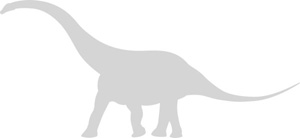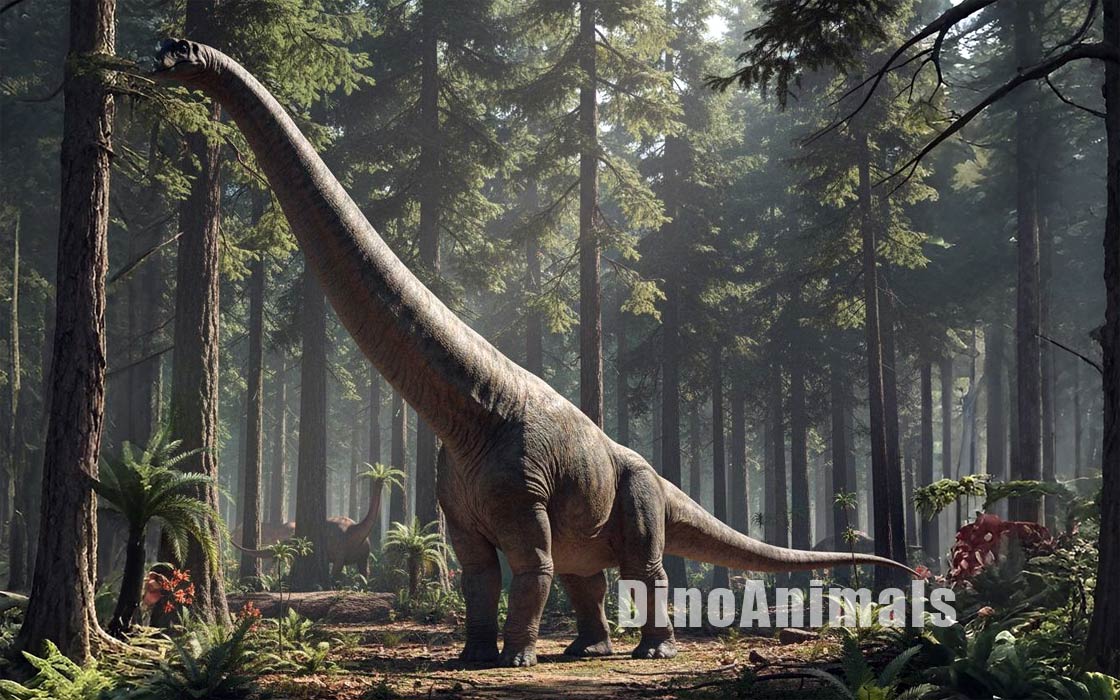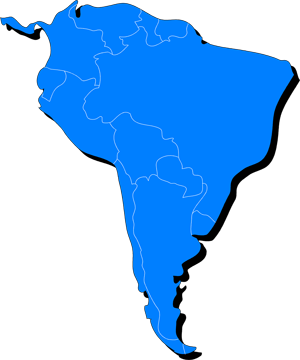Every month, 100,000 readers use the Dinosaur Database, but we receive no support from you. Developing and updating the database requires a lot of work. If you want it to remain open and be updated, please support us via the "Buy us a coffee" button available on every page or via the Support page.
Dinosaur: Dreadnoughtus schrani

| Length*: | 25.5 m | 83.7 ft |
| Weight*: | 47 t | 103,617 lb |
*The largest known specimen
Period
Epoch: Late Cretaceous
Stage: Campanian-Maastrichtian
Years: 76-70 Ma
Details
Status: valid
Author: Lacovarra et al.
Year: 2014
Distribution
Area: South America
Country: Argentina
Region: Santa Cruz
Formation: Cerro Fortaleza
Description
Dreadnoughtus schrani
Dreadnoughtus schrani is one of the largest known sauropod dinosaurs, which lived during the Late Cretaceous period, approximately 76–70 million years ago. Discovered in the Cerro Fortaleza Formation of southern Patagonia, Argentina, this massive dinosaur is notable for its sheer size and completeness of its fossil remains. The name “Dreadnoughtus” is derived from the Old English word meaning “fear nothing,” reflecting its enormous size and the likely lack of natural predators once it reached adulthood. The specific name, “schrani,” honors American entrepreneur Adam Schran, who supported the research.
Physical Characteristics
Dreadnoughtus schrani was an enormous titanosaur, a subgroup of sauropod dinosaurs characterized by their massive bodies, long necks, and whip-like tails. Estimates based on the fossils suggest that Dreadnoughtus measured around 26 meters (85 feet) in length, with some projections suggesting it could reach up to 30 meters (98 feet). It weighed approximately 50-60 metric, making it one of the heaviest land animals known. The neck alone was about 11.3 meters (37 feet) long, composed of at least 12 cervical vertebrae, which allowed it to reach high into the trees for foliage.
The vertebrae of Dreadnoughtus were pneumatized, meaning they were filled with air sacs, a feature that helped to lighten its skeleton despite its massive size. This air-filled structure is a hallmark of many sauropods, contributing to both weight reduction and respiratory efficiency. The limbs were robust and column-like, with the humerus (upper arm bone) measuring about 1.74 meters (5.7 feet) long, supporting the immense bulk of the dinosaur. Its tail was long and muscular, likely used for balance and possibly for communication or defense against predators.
| Dimension | Metric | Imperial |
| Total length | 28m | 91.9ft |
| Head and neck length | 12.2m | 40ft |
| Neck-only length | 11.3m | 37ft |
| Torso and hip length | 5.1m | 17ft |
| Tail length | 8.7m | 29ft |
| Shoulder height | 6m | 20ft |
Diet and Feeding Habits
As a herbivore, Dreadnoughtus schrani primarily fed on plants. The elongated neck enabled it to access a wide range of vegetation, from ground-level ferns and cycads to the leaves of tall coniferous trees. Its teeth were peg-like and adapted for stripping leaves off branches rather than chewing, suggesting that food was swallowed whole and processed in its massive digestive tract.
Given its enormous size, Dreadnoughtus would have required a substantial amount of plant material daily to sustain its energy needs. It likely fed on a variety of plant types, including conifers, cycads, and ferns, that were abundant in the lush, forested environments of Cretaceous Patagonia. Studies suggest that Dreadnoughtus might have moved through different areas to find sufficient food, possibly following seasonal growth patterns of plants.
Habitat and Distribution
Dreadnoughtus schrani lived in what is now southern Patagonia, Argentina, a region that, during the Late Cretaceous, was characterized by a warm, humid climate with extensive floodplains, river systems, and lush forests. The presence of river sediments and fossils of aquatic and semi-aquatic organisms in the same rock layers indicates that Dreadnoughtus may have lived near water sources, which provided both food and protection from the heat.
The discovery site in the Cerro Fortaleza Formation suggests that Dreadnoughtus inhabited a diverse ecosystem alongside other large herbivores, smaller dinosaurs, and various prehistoric animals. This environment provided ample resources, such as abundant vegetation for feeding and water for drinking, and may have served as a migration corridor for many large herbivorous dinosaurs.
Behavior and Social Structure
Although specific social behaviors of Dreadnoughtus are not well understood due to limited fossil evidence, its sheer size suggests that adult individuals were likely solitary or moved in small groups. Given their immense size, adults would have had few, if any, natural predators, making them less dependent on group living for protection. Juveniles, on the other hand, may have formed groups for protection against predators until they reached a size where they were less vulnerable.
Fossil evidence does not currently indicate whether Dreadnoughtus engaged in specific social behaviors like nesting or parental care, but it is possible that, like other large sauropods, it may have laid eggs in communal nesting grounds. The long necks and tails could have been used for visual signals or to maintain spacing while moving in herds, particularly if they traveled between feeding grounds.
Discovery and Research
Dreadnoughtus schrani was first described in 2014 by a team led by Kenneth Lacovara, following its discovery in 2005 in southern Patagonia. The fossil remains represent one of the most complete titanosaur skeletons ever found, with about 70% of the key postcranial elements preserved, including a nearly complete tail, limbs, and much of the neck and torso. This high degree of preservation has provided researchers with invaluable insights into the anatomy and biomechanics of large sauropods.
The fossil was found in fluvial sediments, indicating it was buried rapidly by a river system, which helped preserve its bones from scavenging and decomposition. Ongoing research focuses on understanding the growth rates of Dreadnoughtus, its physiology, and its role within its ecosystem. Studies using biomechanical modeling have also been conducted to explore how such a massive animal moved and how its skeletal structure supported its weight.
Significance and Interesting Facts
Dreadnoughtus schrani is significant not only for its size but also for the completeness of its fossil remains. Its discovery has provided a rare opportunity to study the anatomy and physiology of one of the largest terrestrial animals to have ever lived. The size and completeness of its remains have enabled scientists to make more accurate estimates of the mass and muscle structure of large sauropods.
An interesting fact about Dreadnoughtus is that, despite its enormous size, the fossilized remains are believed to represent a subadult individual that had not yet reached full maturity, suggesting that fully grown adults may have been even larger. This discovery has implications for our understanding of the growth rates and life history of giant sauropods, contributing to a broader understanding of the biology of these prehistoric giants.
Locations
Sources
Material: A large part of the skeleton, referred fragmentary skeleton and femur ?
References: Ullmann, P.V.; Lacovara, K.J. (2016). "Appendicular osteology of Dreadnoughtus schrani, a giant titanosaurian (Sauropoda, Titanosauria) from the Upper Cretaceous of Patagonia, Argentina".




